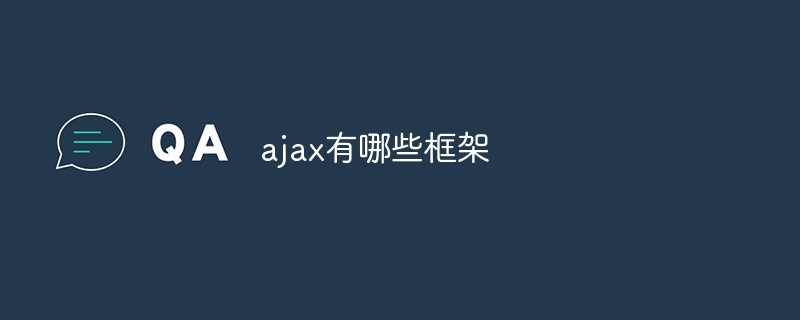
Ajax frameworks include jQuery, Axios, Fetch API, Ember.js, Backbone.js, Angular and React, etc. Detailed introduction: 1. jQuery is one of the most popular JavaScript libraries. It provides a concise and clear API to handle AJAX requests. jQuery also has a rich plug-in library that allows users to quickly implement complex functions; 2. Axios is A Promise-based HTTP client and more.

The operating system for this tutorial: Windows 10 system, DELL G3 computer.
AJAX is a web development technology that uses multiple technologies, including HTML or XHTML, CSS, JavaScript, DOM, XML, XSLT, and most importantly, the XMLHttpRequest object. AJAX is not a single technology, but a combination of multiple technologies. Using AJAX, you can exchange data with the server through asynchronous HTTP requests without refreshing the entire page. This allows developers to create more efficient and faster user interfaces and provide a better experience for end users.
When developing AJAX applications, there are many frameworks available that can speed up development and simplify code. The following are some common AJAX frameworks:
1. jQuery: jQuery is one of the most popular JavaScript libraries, which provides a concise and clear API to handle AJAX requests. jQuery also has a rich plug-in library that allows users to quickly implement complex functions.
2. Axios: Axios is a Promise-based HTTP client that can be used in browsers and Node.js. It provides a simple way to send HTTP requests, and has the ability to intercept requests and responses, making it easy to handle asynchronous operations.
3. Fetch API: Fetch API is a built-in API in modern browsers for sending HTTP requests. It returns a Promise object, making asynchronous operations easier to handle. The Fetch API provides functionality similar to the $.ajax() method in jQuery.
4. Ember.js: Ember.js is a complete client-side framework that provides many functions, including template engine, routing and AJAX functions. Ember.js uses the Ember.RSVP module to handle asynchronous operations, which returns a Promise object.
5. Backbone.js: Backbone.js is a lightweight JavaScript framework that provides models, views and AJAX functions. Backbone.js uses jQuery or Zepto.js as the underlying library to handle AJAX requests.
6. Angular: Angular is a complete client-side framework developed by Google for building single-page applications. Angular has AJAX functionality built into it, using the $http service to send HTTP requests.
7. React: React is a JavaScript library used to build user interfaces. Although React does not provide AJAX functionality directly, you can use third-party libraries such as axios or fetch to send HTTP requests.
These frameworks all provide different methods and APIs to handle AJAX requests, and have their own advantages and disadvantages. Which framework to choose depends on the specific needs of the project and the preferences of the developer. When choosing a framework, you need to consider factors such as the size of your project, development time, performance requirements, and the skill level of your team.
The above is the detailed content of What frameworks are there for ajax?. For more information, please follow other related articles on the PHP Chinese website!
 ajax tutorial
ajax tutorial
 Ajax Chinese garbled code solution
Ajax Chinese garbled code solution
 What to do if ajax transmits Chinese garbled characters
What to do if ajax transmits Chinese garbled characters
 Introduction to the framework used by vscode
Introduction to the framework used by vscode
 What does gprs network mean?
What does gprs network mean?
 How to solve dns_probe_possible
How to solve dns_probe_possible
 The difference between c language and python
The difference between c language and python
 Popular remote connection software
Popular remote connection software
 jquery validate
jquery validate